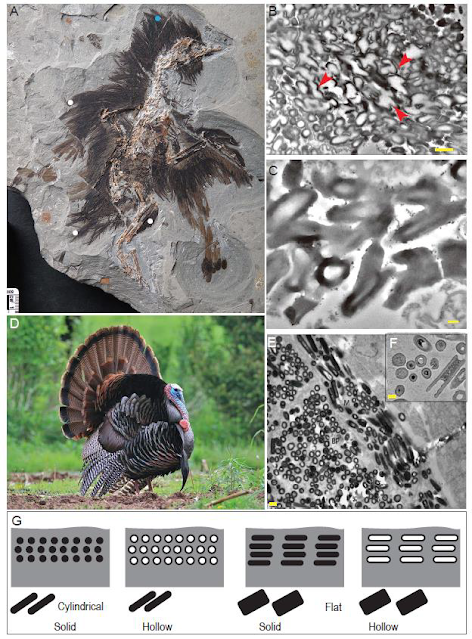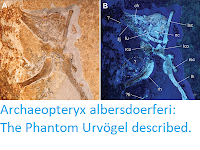Modern Birds produce a wide range of pigments, enabling them to produce a wide range of coloured feathers. In many species, this is further enhanced by the addition of structural colours, which enable iridescent plumage colouring not seen in any other terrestrial organisms except some insects. This is achieved through the presence of photonic crystals with periodic changes in their refractive index (i.e. as light passes through the crystal it encounters multiple refractive layers which scatter it in the same way that a water or glass surface can. In the case of Birds, this is done with the aid of stacks of transparent, melanosomes (pigment cells) within the keretin of the feather. Four different types of iridescent melanosomes have been found in modern Birds, solid cylindrical, solid flattened, hollow cylindrical, and hollow flattened, with the flat and hollow forms having no analogue in non-iridescent feathers.
Melanosomes were first discovered in the feathers of fossil Birds a decade ago, and have enabled the recreation of colour schemes in a number of long-extinct species, but iridescent melanosomes have yet to be conclusively shown in a fossil Bird.
In a paper published in the National Science Review on 28 December 2021, Pan Yanhong of the State Key Laboratory for Mineral Deposits Research at Nanjing University, Li Zhiheng and Wang Min of the Key Laboratory of Vertebrate Evolution and Human Origins at the Nanjing Institute of Vertebrate Paleontology and Paleoanthropology of the Chinese Academy of Sciences, and the Center for Excellence in Life and Paleoenvironment, Zhao Tao, also of the State Key Laboratory for Mineral Deposits Research at Nanjing University, and Xiaoli Wang and Xiaoting Zheng of the Institute of Geology and Paleontology at Linyi University and the Shandong Tianyu Museum of Nature, present evidence for iridescent plumage in the Early Cretaceous Bird Eoconfuciusornis zhengi, the earliest branching stem Avialan with a beak
Pan et al. examined a specimen of Eoconfuciusornis from the collection of the Shandong Tianyu Museum of Nature, which had previously been shown to have preserved melanosomes in its feathers, using scanning electron microscopy and tunnelling electron microscopy. They found many of the melanosomes were visibly hollow rods with a circular cross section, resembling the hollow melanosomes found in the feathers of modern Birds such as African Starlings, Birds of Paradise, and Wild Turkeys.
These hollow melanosomes would have contained air in life, with a much lower refractive index (abour 1.0) than the pigments found in non-hollow melanosomes (roughly 2.0 for melanin and 1.58 for beta keratin). This would have created a series of refractive surfaces in each melanosome (the first where light hit the external surface of the melanosome, the second where it passed from the internal surface into the air held in the hollow centre, the third where it passed from that air pocket into the opposing interior surface of the melanosome, and the final one where it left the melanosome), which could be amplified by having stacks with large numbers of melanosomes.
Pan et al. suspect that the hollow melanosomes of Eoconfuciusornis are a separate evolutionary innovation to those of modern Birds (an example of convergent evolution). They note that all of the hollow melanosomes found were from the crown of the head, and that this makes it likely that they were used in some form of display. The use of feathers for display purpose has previously been proposed for a range of Mesozoic Birds and Dinosaurs, due to the large and conspicuous feathers found on their tails.
See also...



Online courses in Palaeontology.
Follow Sciency Thoughts on Facebook.
Follow Sciency Thoughts on Twitter.




